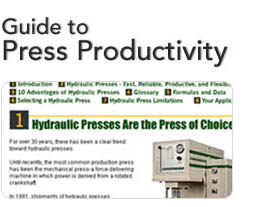| Greenerd builds presses that fit its customers’ needs
Greenerd Press & Machine Co. Inc., Nashua, N.H.,
has been in business since 1883 and started building
hydraulic presses around 1935. Since then, the
company has continued to evolve and now works with
customers to create presses that fit specific applications.
It was not always possible to
create a customized press. Tom
Lavoie, applications and customer
service manager, comments
that “through the years
we had standard designs because
back then a lot of today’s
frames were not fabrications but
were castings.
“For a long time we had a
range of presses that were made
using these castings. Around the
mid-1960s to early 1970s, we
began to fabricate frames by
taking steel plate and welding it.
At that point we could offer any
size machine. Tonnage wasn’t a
concern anymore, as far as the
overall size of the machine went.
With the castings, you were kind
of limited to a certain tonnage
range to get a larger daylight,
stroke or table size.”
Take your pick
Today, customers have the option to choose a customized
press over a standard press, which allows them to fit the
machine to the application. “Today, production methods are
getting more involved,” says Lavoie. “Instead of customers
making a standard press work in the application, with a little
or a lot of customization they can make it a true fit.”
And, when it comes to custom presses, customers can get
just about anything. “The hydraulic circuit, as far as speeds,
can be customized,” says Lavoie. They can also get “multiple
cylinders being actuated synchronously and any table size.
We’re not really limited today at all when it comes to the
overall size of the press, other than maybe a customer
limitation to get it in their facility. We can also customize
controls to a particular process or application and design the
hydraulics to meet that same application, as well as the
frame and the tonnage, too. We make the press so that it is
what the customer needs—not necessarily something they
have to accept,” says Lavoie.
Eliminating the guesswork
And, there’s no reason to be nervous about ordering a
customized press. Lavoie and Mike Moran, national sales
manager for Greenerd, talk with every customer that calls in
for a quote. Lavoie says that they do this “because the
particular application for the
customer may not trigger anything
in their mind as far as an option or
a customization that might work
better for their situation, but Mike
and I are on the phone every day
with many customers. We see tons
of applications, and sometimes
when someone calls us up and says
that they’re trying to do something,
there are options that we have done
before that will help them. We
work very hard with our customers
to try to understand what they are
going to be doing so their press has
the features necessary to accomplish
the task.
Greenerd does all sales, design
and build, and service from its plant
and is very involved with the ANSI
B-11.2 requirement. “This is an
important specification,” says
Lavoie, “because it allows for
redundancy in both your hydraulic and electric controls. All of
our presses built today meet the ANSI B-11.2 specification.”
Lavoie also notes that “85 percent to 90 percent of what we
do is custom.” He says that custom may mean adding just a
couple of inches to table size, a larger daylight or stroke.
“Customization really means that you can’t pull it out of the
catalog.” The company’s main customers include Tier 1, Tier
2 and Tier 3 automotive; foundries; foodservice; metal
stamping; and compression molding. “It’s really a varied
customer base,” said Lavoie. “In the past few years, stamping
and a lot of the metals work has gone overseas. So we’ve
begun to look at other applications, such as the compression
molding market here in the United States, which is
growing—as opposed to dwindling—and trying to make
inroads into those markets. |

















